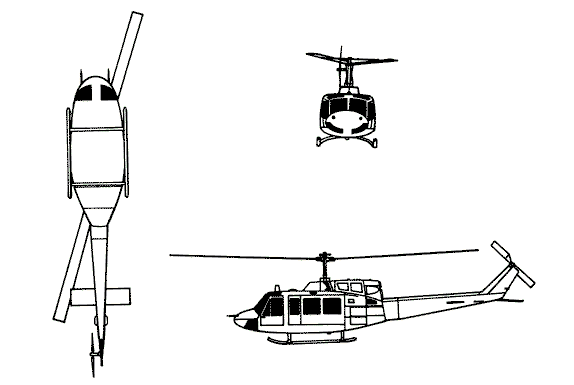 The most widely used military helicopter, the Bell UH-1 series Iroquois, better known as the "Huey", began arriving in Vietnam in 1963. Before the end of the conflict, more than 5,000 of these versatile aircraft were introduced into Southeast Asia. "Hueys" were used for MedEvac, command and control, and air assault; to transport personnel and materiel; and as gun ships. Considered to be the most widely used helicopter in the world, with more than 9,000 produced from the 1950s to the present, the Huey is flown today by about 40 countries.
The most widely used military helicopter, the Bell UH-1 series Iroquois, better known as the "Huey", began arriving in Vietnam in 1963. Before the end of the conflict, more than 5,000 of these versatile aircraft were introduced into Southeast Asia. "Hueys" were used for MedEvac, command and control, and air assault; to transport personnel and materiel; and as gun ships. Considered to be the most widely used helicopter in the world, with more than 9,000 produced from the 1950s to the present, the Huey is flown today by about 40 countries.Specifications | |
| Primary function | Utility helicopter |
| Manufacturer | Bell Helicopter Textron |
| Power plant | Pratt and Whitney T400-CP-400 |
| Power | Burst: 1290 shaft horsepower (transmission limited) Continuous: 1134 shaft horsepower (transmission limited) |
| Length | 57.3 feet (17.46 meters) |
| Height | 14.9 feet (4.54 meters) |
| Rotor Diameter | 48 feet (14.62 meters) |
| Speed | 121 knots (139.15 miles per hour) at sea level |
| Ceiling | 14,200 feet (4331 meters) (limited to 10,000 feet (3050 meters) by oxygen requirements) |
| Maximum takeoff weight | 10,500 pounds (4,767 kilograms) |
| Range | 172 nautical miles (197.8 miles) |
| Crew | Officer: 2 Enlisted: 2 |
| Armament |
All three weapons systems are crew-served, and the GAU-2B/A can also be controlled by the pilot in the fixed forward firing mode. |
| Introduction date | 1971 |
| Unit Replacement Cost | $4,700,000 |
| Marine Corps Inventory | 107 |














UH-1N







No comments:
Post a Comment